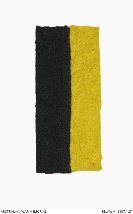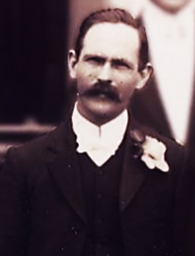Henry BELL
Eyes blue, Hair dark brown, Complexion dark
Harry - Killed in action
Private Harry Bell was reported as missing just after the first anniversary of his enlistment but his wife and family were not notified until 28 August 1916. After this advice there were numerous letters from Dorothy, his sisters and from his brother John seeking information about Harry’s fate. Dorothy (also known as Isobel) went so far as to include personal letters for Harry in the hope that he would be found to be a prisoner of war in Germany and that her letters could be sent on to him. The extracts from just a few of letters – one from John and three from Dorothy - tell something of the desperate wait for news.
On 17 September 1916, John writes:
I would be extremely grateful if you could do anything to help us. My brother was married just before he left. His wife and all of us are exceedingly anxious concerning him, though we hope and pray for the best.
On 29 October 1916, Dorothy writes:
"I have tried a number of people to see if we could receive any news of him…………so if you can help me in any way I will thank you from my heart"
On November 1916:
"As the waiting is dreadfull (sic) we are trying every means that might help."
And on 10 December 1916:
"It is a long weary waiting as I have told you before."
Eventually, Harry’s name appeared on the German Death List and the following letter was sent to Dorothy in December 1916 by the Red Cross advising her that he had been killed.
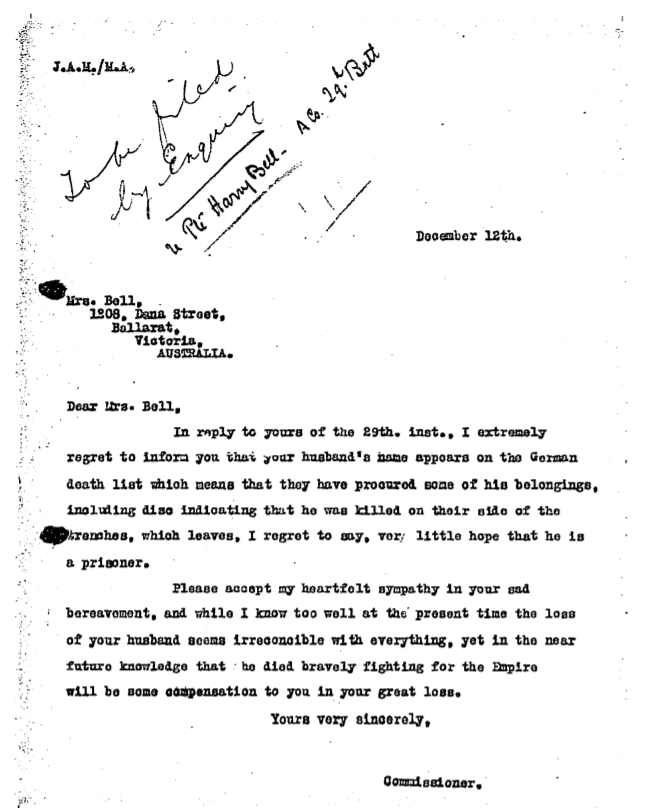
It was however a further three months (March 1917) before the army’s official enquiry found that Harry had been killed in action on 19th July 1916. That enquiry relied on evidence from fellow soldiers of the 29th Battalion including 317 Private Matthew O’Shannassy who stated:
"I saw him killed by a shell about the same place as Haslan, In a German Trench at Fromelles as we were coming back to the 1st line"
Another statement from Informant 1103 Private David Edney read:
"Bell was killed at Fleurbaix on the 19th July 1916. On the morning of the 20th or 21st July, in the daylight, I went out with others to fetch men from No Man’s Land under cover of mist. I brought Bell in, and placed his body with others. He was afterwards moved to the back for burial. I am not able to say how or where he was buried. I did not see him killed."
And one more statement from 223 Sergeant Harold P. Downer:
"I saw the casualty killed in the second line of German trenches at Fleurbaix on the 20th July 1916. Casualty was in the trench which we just occupied when he was destroyed by H.P. shell. The body was not buried"
As next of kin, Dorothy would have finally received Harry’s identity disc in November 1917 but no other personal effects were found.
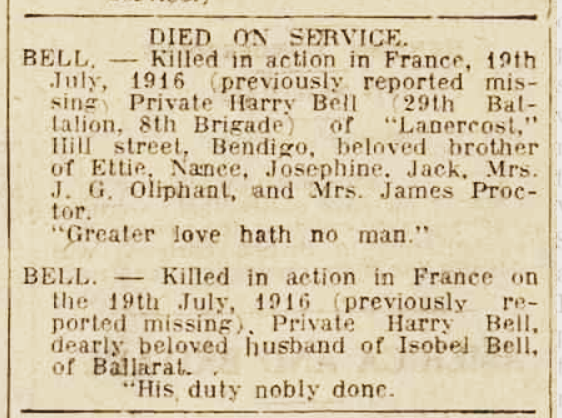
Finding Harry – through his letters home and through DNA
Recollections from Barbara
“I can also remember being shown by my mother a small album of beautiful postcards. These were mostly written by Harry mainly to his sisters during the war but also included some from Harry’s nephew - Corporal Ken Oliphant, who also fought in France but fortunately returned home, wounded but safe.
My mother had also carefully kept in an old trinket box, several letters written by her parents years ago, plus a few from Uncle Harry.
After my mother’s death in 2004, I acquired these cards (which were no longer in an album) and letters and I have kept them safely stored in a wicker chest.”
In about 2009, Barbara received a phone call from a distant cousin informing her that Henry was one of the soldiers expected to be found buried at Fromelles after lying undiscovered for almost a century! She was amazed and stunned! It was truly incredible.
With emotions and affection for this uncle she had never known flooding over her, Barbara immediately sought out the postcards and letters stored away in the wicker chest. One by one she placed them again in an album, the letters in plastic sleeves, and sat down to read them all several times. In doing so, she began to know her great uncle – her grandfather’s big brother - who did not return from the war. Barbara discovered that he wrote very well and it almost felt as though Harry was reaching out from the grave and sharing his thoughts and feelings and his sense of fun. These letters built a real sense of family connection as the close relationship Harry shared with his brother and his sisters became clear through his writing.
Harry enjoyed writing letters, mentioning in one, “this is the fifth and I’ve got as many more to write”. In some, he’d just written “he was well, longing to get mail, hoping family were all well” etc., while in others he commented on topics from family letters and commented in one that he had enjoyed reading an article in the 'Bedigonian' that his sister had sent him.
He also wrote “we could, of course, say lots of things but then they would only be rubbed out when they go through the censor’s hands” . Not surprisingly, he mentioned keeping a personal diary where he was able to write things that couldn’t be censored and that he had just added “something to it that will interest you all and perhaps a little later I will be able to let you know about”. Sadly, the whereabouts of his diary is unknown - perhaps it may have fallen into German hands or was destroyed in the trenches. What became of it is a mystery, but one thing is for certain, it would have been truly fascinating to read!!
Barbara has picked out some gems from Harry’s correspondence including,
“He loved cakes and sweets and was intending on “gorging” himself when he received a parcel of long-awaited goodies from home”
He suffered from rheumatism and when his knee went “pretty lame” Lieutenant Johnson who was marching behind him offered to carry his rifle but Harry wouldn’t let him. Harry writes, “He wanted to know what was wrong with me, I told him my leg was a bit crook for the time, anyhow when we got here they gave me a light job for awhile. We’ve got great officers. They were picking out all those with rheumatism so I kept clear of 'Catona'.” (Catona is the best guess at an illegible word, possibly a slang term.) He goes on to say, “It means probably some sort of a job here or home again if bad and that would be no good to this chick.”
He suggests that 'Brighton Beach' (somewhere in Egypt) was tough:
"I lost enough sweat out there to start a young canal, every day I was ringing (sic) wet with perspiration and strange to say it didn't take me down in condition at all, I weighed myself the other day and I weighed 12st 12lb, not a bad weight, eh. The sand at Brighton Beach was the worst I've been in and that is where we had that pearler of a sand storm"

Harry was not a fan of the weather or the flies, saying:
"It's a stinging hot day today. It’s a bit better now and up to a few minutes ago the flies were brutal. The bally things seek out all the cool spots like we do"
Another time he was:
"hauled out of the canal after the wreck of the Alouette by some of the Indian Troops who he’d been great pals with."
"they helped me to the hospital and some of the Indian soldiers lent me one of their big coats and a shawl, I looked a pet with just a shawl around my hips and a coat on."
In a letter dated 7th May 1916, he commented that they were kept in the dark about military plans noting:
"Well we havn't (sic) moved yet, but it will come when we least expect it, we will be marched off one of these times and wont know where to till we are on the boat and then we wont know our destination till we land there."
"It wouldnt do to tell no fellow to (sic) much. I believe we are as bad as a lot of old women for talking, but what can you expect, May, when there are such things as Insurance Agents in the army."
May was John’s wife, Mabel, – a lady who clearly wondered about the usefulness of insurance agents in a war zone!
His letters and cards also mention a range of details about the time in Egypt:
“Our packs are always packed ready with the things we have to take with us. Viz. pair socks, change of under clothing, overcoat, carry all, towl (sic) & soap, all issue stuff, we are not allowed to take private stuff. So you see we could get off at very short notice.”
“Some of the other brigades here have some pet names for us such as – Chocolates & Pets and the latest is The Gentlemen of the Desert. I suppose all of that will drop when we are shoulder to shoulder.”
In yet another card he mentions getting their helmets and colour:
“the helmets are just the thing for this hot weather” he writes. “Our colours are black and gold, they don’t look bad on our tunics”.
In addition to Harry’s correspondence, his brother, John, wrote to Harry weekly. The letters demonstrated the deep respect and affection that they shared and clearly showed John’s concern and anguish while his brother was so far away, facing the conflict and the horrors of war. Barbara empathised with her grandfather’s sense of frustration at not being able to do more, feeling helpless, and wanting to join Harry on the Western Front. John, however, had a wife and four children and was also the sole teacher /headmaster of a school in Leichardt. Some of the letters were written long after Henry had been killed but while the family endured the agonizing wait for official news clinging to hope that he may still be alive and taken prisoner of war. It is impossible to imagine the pain family must have endured - like so many others also waiting for news - any news - of a lost loved one.
These cards and letters have been an amazing insight for family who never got to know Harry Bell but they can now see connections previously unknown, for instance a common interest in rose breeding across the generations. Harry, aside from his passion for poultry, was secretary of the Bendigo Rose Society and years later his nephew, Ron, also became a prominent rose breeder. John Bell too was a rose breeder.
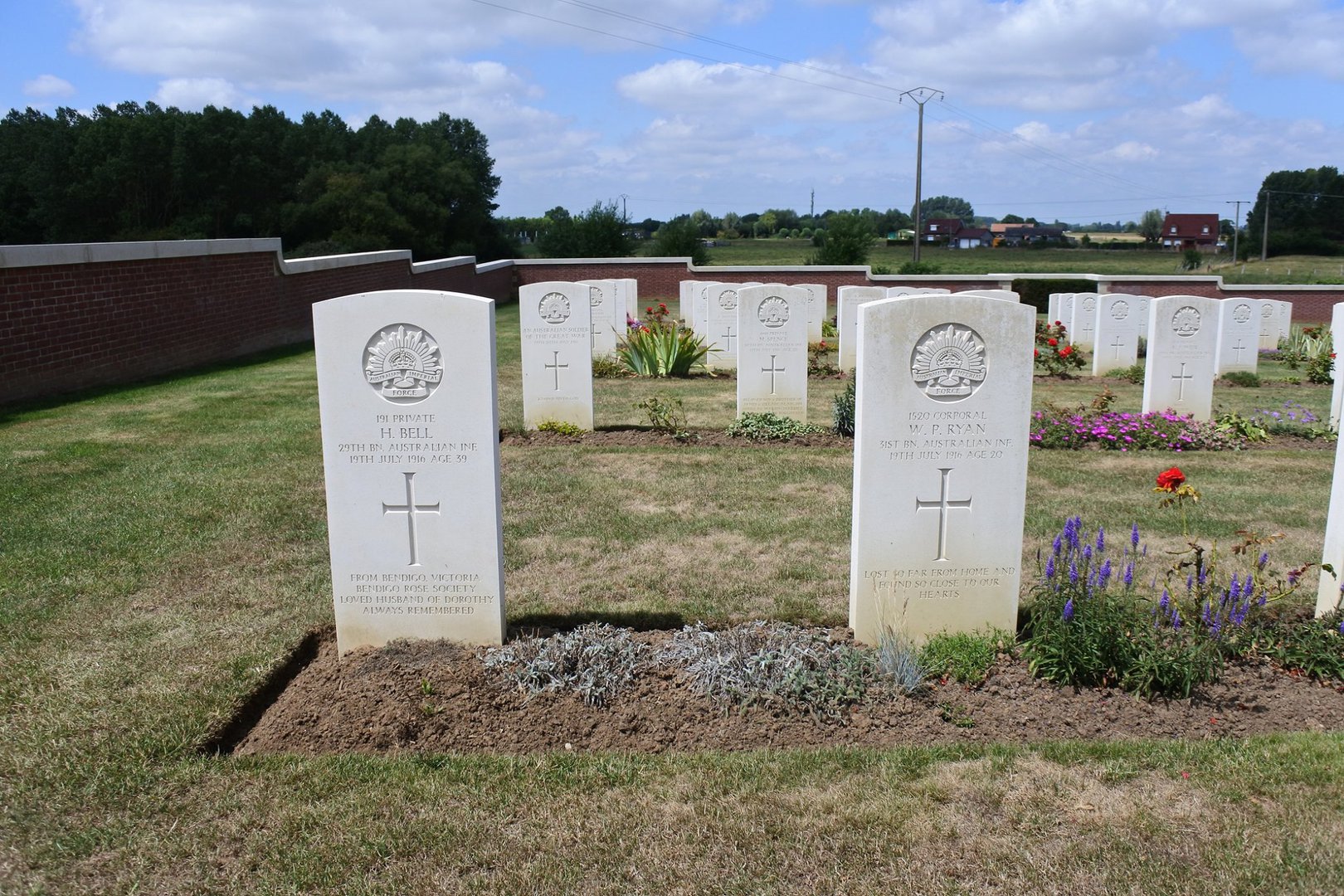
And finally, in April 2018 it was officially announced that DNA identification had confirmed the identity of Private Harry Bell. He now has a headstone inscribed with his details in the Pheasant Wood Military Cemetery. Always remembered.
Recollections from Barbara
“When I received the formal notification that my long-lost great uncle, Henry Bell, had formally been identified using DNA, I remember initially feeling disbelief. I think I may have asked ‘Are you absolutely sure its him’?
After so many years, a positive result in identifying Henry had seemed to be slipping further from reach. I dared to hope such a thing was still possible. However, only days before I was notified, I had sent some old stamps from the early 1900’s (originally sent from Henry’s sister) to Canberra in the hope that they may possibly help solve the conundrum as to who Henry was.
Miraculously, they were not needed after all! Yes, Henry had certainly been identified and any doubts faded to absolute joy! Finally, finally the missing piece of the jig saw puzzle had been put into place! Private Henry Bell would rest with a headstone bearing his name in the little cemetery in Fromelles where he fought and died for his country over a hundred years ago.”
Harry and the maiden aunts
Based, with thanks, on a story written by Henry’s great niece, Barbara, in 2009 together with additional material from Fromelles Association and other researchers.
Recollections from Harry’s great-niece, Barbara,
“From the time I was a child, my mother told me about her uncle Harry who was killed in Fleurbaix, France during the First World War. As a young girl holidaying with her maiden aunts, Mum had to ‘salute’ each morning a photograph of Harry in uniform that her aunts had proudly displayed on the wall. She didn’t really understand why but she understood that it was imperative that she carry out this ritual or she’d be reprimanded.”
Henry (always known as Harry) was one of twelve children born to Henry senior and Jane (nee Carruthers) Bell in Bendigo in 1876. Sadly, only eight children reached adulthood – two sons and six daughters.
Henry Snr and Jane left Cumberland in the north-west of England with their five eldest daughters on 18th September 1871. They had paid their 75 pounds fare and were bound for Melbourne, Australia aboard the Duke of Edinburgh, a part of the White Star Line. How brave was it of them to have embarked on such a voyage at that time – with their youngest merely eleven months of age!
On arrival in Australia, a further three children were born – Josephine in 1874, Henry in 1876 and John James in 1877. The three older sisters married but the three youngest - Henrietta (Ettie), Annie (Nance) and Josephine - did not. These three sisters are buried with their parents in the family plot in Bendigo and, presumably, they are the maiden aunts from Barbara’s mother’s childhood recollections.
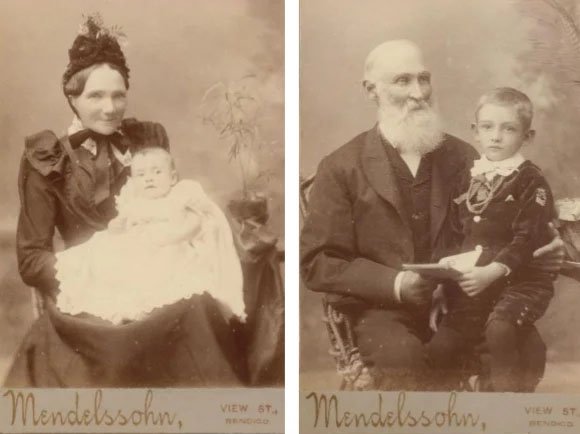
Harry Bell – a smile and a friendly word
Recollections from Barbara
“Another thing I can remember my mother telling me with a smile years later, was that Uncle Harry, according to her father, had quite the reputation of being a ladies’ man when he was younger! He had an eye for a pretty face and liked women”
Harry was born and bred in Bendigo, Victoria where he attended Corporate High School. By the time Harry enlisted in the army he was in his late 30's, so he was certainly not a young man, unlike many of those whom he fought beside. He had an established career as an insurance agent with the National Mutual Life Insurance Company and had been a secretary of both the Bendigo Rose Society and the Bendigo Poultry Society.
He was a keen poultry breeder, particularly the Golden Wyandotte, for which he won numerous prizes. He was very active in promoting and expanding the poultry and egg industry in the region. An obituary written in the poultry notes of section of The Bendigo Independent described Harry as follows:
"He had a smile and a friendly word for everyone he met, and was never happier than when in the company of poultrymen. Particularly pleased was he to welcome visiting poultrymen to the city, and show them everything possible that could interest them. He was a progressive man, and a born organiser, and had he been able to continue in office it is hard to imagine what would have been the bounds of poultry in the district."
Clearly, Harry was a personable and popular poultry enthusiast. We don’t know for sure if he was a “ladies’ man” as suggested by his younger brother, John (grandfather to Barbara), but it certainly sounds like it fitted with his personality. Irrespective of this label, we do know that Harry gave up his bachelor status, marrying Dorothy Isabel Bentley in 1915 just before heading off to war. There were no children of the marriage.
The Photo Mystery – is this Harry?
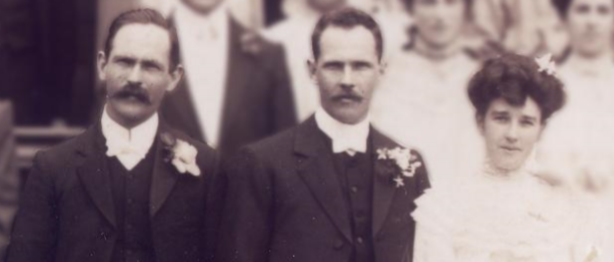
Recollections from Barbara
“The photo that I keep in my album, I know without a doubt is Henry Bell. It was taken on 18th April 1906 when he was best man to my grandfather, John James Bell. That image staring back at me with a hint of a smile is Harry, my great uncle. He was once obviously, a handsome man, this Harry who now has, and always will have, a special place in my heart.”
The family have a photo of Harry, aged 30, taken when he was bestman for his brother Jack’s wedding in April 1906. There is another photo held by the Australian War Memorial that is identified as Harry but family members believe it may be an error. The photo in question is a soldier in uniform but it seems to be of a man younger than the 38 years that Henry had attained by 1915. Has an error been made? It would be wonderful if the photo of the soldier that Barbara’s mother saluted as a child was available to help solve this mystery.
The Fromelles Association would love to hear from you

Contacts
(Contact: carla@fromelles.info or geoffrey@fromelles.info).
(Contact: army.uwc@defence.gov.au or phone 1800 019 090).
Donations
If you are able, please contribute to the upkeep of this resource.
(Contact: bill@fromelles.info ).

